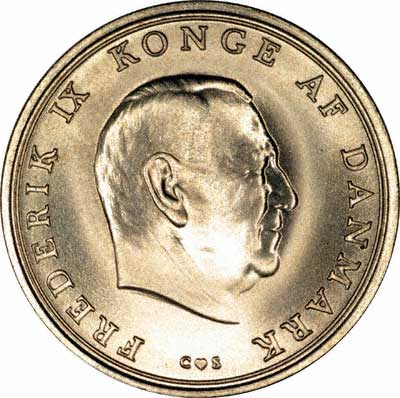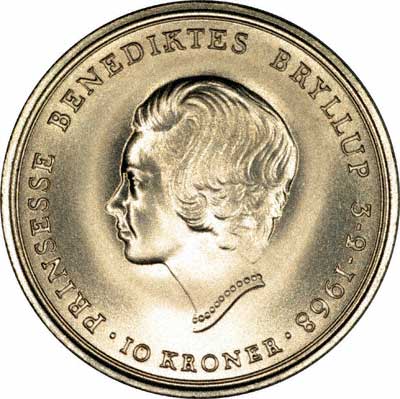| The Very Highest Quality Information... |
| Danish Coins |
|
| ||||||||||||||||||||||||||||||||||||

| ||||||||||||||||||||||||||||||||||||
|
| ||||||||||||||||||||||||||||||||||||
|
| ||||||||||||||||||||||||||||||||||||

| ||||||||||||||||||||||||||||||||||||
|
| ||||||||||||||||||||||||||||||||||||
Ancient History
Denmark is thought to have derived its name from the Dani, a Germanic Northern tribe, who once lived in the area. Although the Roman Empire never even approached the borders of what is now Denmark, there is much evidence to suggest that Danish warriors often served in the Roman Armies as mercenaries.
During the Dark Ages, Angles and Jutes from what is now Denmark (along with Saxons from Northern Germany) frequently raided Roman Britain, and later, following the abandonment of Britain by the Romans, invaded and settled what is now England, which was ethnically cleansed of native British inhabitants as far as the Welsh and Cornish borders.
Vikings
Later Danes became skilled seafarers, engaging in trade and exploration as far as Greenland and North America. However, in 793 AD, a group of these Danish seafarers had noted that the isolated Abbey of Lindisfarne, in northern England was full of rich treasurers and relatively unprotected. Lindisfarne was therefore pillaged and its monkish inhabitants slaughtered. Thus began the Viking age.
The Danish Vikings then developed that habit of raiding unprotected coastal towns and communities along the coasts of Europe, with each successful raid encouraging further raids. Due to their proximity, the British Isles and the Franks (France) were particularly hard hit.
In the middle of the 9th Century, the Danes diversified from mere raiding into outright conquest, and established settlements in Ireland, England (with the area occupied by the Danes becoming known as 'the Danelaw'). Later, in the 10th Century, Danes under Rollo were allowed to settle in Normandy in return for protecting the Kingdom for further raids.
In 965, Denmark was united for the first time under Harald Bluetooth, who also converted to Christianity and earnestly worked towards establishing Denmark as a united Christian kingdom. Bluetooth also commissioned the Jelling stones, which tell the story of his uniting Denmark and conversion to Christianity.
By the late 11th Century, the Christianisation of Denmark was more or less complete and the Viking age came to an end.
Medieval Denmark
As Denmark entered a period of Christian Feudalism, the King gained powers at the expense of local Earls (Jarls) who had previously been semi-autonomous vassals, although the nobility remained influential.
During this period, Denmark often found itself in competition and rivalry with the Holy Roman Empire and the Northern German Hanseatic League over issues such as territory and trade in the Baltic and North Seas.
Kalmar Union
In 1396, Eric of Pomerania, King of Norway, also became King of Sweden and Denmark, thus becoming the first King of the Kalmar Union. Sweden proved to be a reluctant member of this union. Frequently rebelling against Danish rule, until in 1523 when Sweden successfully and decisively broke away and became a separate kingdom again.
Norway and Denmark remained in personal union with each other until 1814, when following Denmark's defeat during the Napoleonic Wars, Norway was annexed by Sweden.
Later History
Denmark was an absolute monarchy until 1849, when following the revolutions that swept through Europe in the previous year, the new King, Frederick VII signed a constitution establishing a constitutional monarchy. In 1864, Prussia fought a war with Denmark for control over the Duchies of Schleswig and Holstein, which the Danish lost.
Although Denmark remained neutral during World War One, she regained Schleswig by plebiscite in 1920.
In World War II, Denmark was invaded and occupied by Nazi Germany. Despite being occupied, Danish civil government was allowed to continue, and this government resisted attempts by the Germans to deport Danish Jews. As Nazi authority over Denmark intensified after 1943, the Danish Navy sabotaged its ships and many of its officers fled to neutral Sweden.
In the years since the war, Denmark joined the EEC (which later morphed into the EU) in 1973, along with Britain and Ireland, and is a full member of NATO.
Coinage in Denmark
Roman coin hoards discovered in Denmark suggest that trade links existed between the Danes and the Romans in ancient times, and were perhaps used for overseas trade, rather than general circulation.
However, coins were first minted in Denmark under Sweyn Forkbeard in 995. The coins minted were silver pennings (pennies), and may well have been influenced by their dealings with Anglo-Saxon pennies looted and traded for by the Danes. In 1625, the Danish currency system was reformed, with 12 Pennings to the Skilling (shilling) and 16 Skilling to the Mark, with 6 Marks to the Rigsdaler. In 1713, the currency was divided into two systems, courant and specie, with the former a debased version of the latter, which was still strictly tied to a precious metal standard. By the time the currency was reformed again in 1813, the Specie Rigsdaler was worth 12 times that of its Courant equivalent. The 1812 reform, brought about by Denmark’s disastrous involvement in the Napoleonic Wars, established the new Rigsbankdaler at 6 Rigsdaler Courant to the Rigsbankdaler, subdivided into 96 Rigsbankskilling. With the disappearance of the Speciedaler, the new currency was renamed Rigsdaler in 1854.
The Rigsdaler was abolished when, with the formation of the Scandinavian Monetary Union in 1873, the Rigsdaler was replaced by the Krone (Crown) at 2 Kroners to the Rigsdaler. Although the Scandinavian Monetary Union broke up in 1914, the name of the Danish currency has remained the same down to the present day.
In 2000, a referendum on Denmark joining the Euro failed, and Denmark retained the Kroner. Modern Danish coins are denominated in Kroners, subdivided into 100 Ore.
For Sale and Wanted
If you are interested in coins from Denmark please see our product index:-
Danish Coins
Gold Coins
We also have gold coins from Denmark on our taxfreegold website:-
Danish Gold Coins
| ...at the Lowest Possible Price |
|
32 - 36 Harrowside, Blackpool, Lancashire, FY4 1RJ, England.
Telephone (44) - (0) 1253 - 343081 ; Fax 408058; E-mail: info@chards.co.uk The URL for our main page is: https://24carat.co.uk |
Web Design by Snoop |